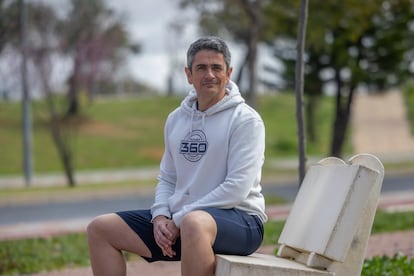Life after Ozempic
Half of the people who take these weight loss drugs stop treatment within a year. Most regain two-thirds of their lost weight, but a new study suggests there is a way to avoid the rebound effect

Losing weight is surprisingly easy. So is gaining it back. The blockbuster drug — GLP-1 receptor agonists — has been shown to help patients lose around 15% of their body weight. The Holy Grail of diets is injectable, its commercial name is Ozempic, and it costs between $900 and $1,300 a month (in the United States). But its cost is about more than just money. The drug creates a constant feeling of satiety, and feeling full in an obesogenic world is not easy. In our daily lives, social plans often revolve around eating or going out for drinks. Ozempic takes away the desire to eat, and in many cases to drink. What’s more, it can leave a person feeling constantly nauseous. These are some of the reasons why, despite the drug’s effectiveness, up to half of its consumers stop taking it within a year. And as they return to their routines, the kilos come back too. However, a new study suggests there may be a way to avoid the rebound effect: exercise.
To reach this conclusion, researchers from the University of Copenhagen (Denmark) contacted the participants of an old study that they published in 2020. In that first study, they analyzed 195 obese people who lost 10 kilos and maintained that weight. One group supplemented the diet with a treatment of Saxenda, one of the first GLP-1 agonists. Another took the same drug and also followed a supervised exercise program, with two spin classes and two runs per week. A third group was given a placebo. After a year, almost everyone taking the drug had kept the weight off or lost more weight. The results were published in the New England Journal of Medicine and the participants returned to their lives without supervision or guidelines.
That’s when the most revealing part of the study began. After a year, the researchers invited the participants to return to the laboratory. A total of 109 returned and had their weight, body composition and current exercise habits checked. For some, the year had been disastrous. The participants who hadn’t kept up the exercise routine regained around 70% of the weight they lost. What’s more, most of these regained pounds were in the form of fat, not muscle, so the participants ended up with a higher body fat percentage than before they started taking the drug. In other words, they got worse. “They had gained unhealthy weight,” explained Signe Sørensen Torekov, professor of biomedical sciences at the University of Copenhagen and lead author of the study. On the other hand, the people who had continued to exercise on their own were able to better maintain their weight and preserved more muscle mass. The results clearly indicate that people taking these drugs can “maintain a healthy weight” even after stopping the medication. “But they need to exercise,” Torekov added.
The new study was funded, in part, by the Novo Nordisk Foundation, a charity affiliated with the maker of Saxenda, although the company did not oversee the study or its results. The drug used in the study has also been surpassed by more advanced versions, but the authors and other specialists consulted believe that the research results are applicable to the rest of the drugs in this class.
Kilos per injections
A little less than a year ago, EL PAÍS reported on the popularity of Ozempic in Spain, giving two specific cases as examples. María (not her real name), a 36-year-old from Madrid, had lost about seven kilos with the injections. She did not combine the treatment with a diet or exercise, but since she was never hungry, she lost weight without much effort. María then decided to stop taking Ozempic shots and went back to her old habits. “I’ve gained weight again,” she answers in an exchange of messages. “I was injecting myself for four months, then I stopped.” Asked about why she stopped taking a drug that worked, María explains that she lost the amount of weight she wanted and that day-to-day life with Ozempic was not very pleasant. “The way it is administered, via injections, made it a bit of an effort. I found it uncomfortable. And then there was the difficulty of getting it, the nausea… In short, I gave it up,” she explains. A year later, she weighs as much as when she started the injections.
Javier Díaz, a 45-year-old from the Spanish city of Seville, combined the treatment with a strict exercise routine. A year ago, in his interview, he boasted that he could do 100 squats a day. And he continues to do so, as he has maintained his exercise habits. “Two days a week, I have a personal trainer and three days a week, I do free training,” he explains in an audio message. “I do crossfit, functional training, I mix cardio and strength, and I walk a lot with the dog… Right now, I’m taking an hour-long walk with him.” Díaz stopped taking Ozempic eight months ago. But he didn’t stop exercising. His weight has remained stable during this time, between 81 and 82 kilos.

“This is a clear example of how the drug can help,” explains Cristóbal Morales, his endocrinologist. “It is a very common case. Stress, lifestyle habits, work... These are factors that influence a patient’s weight. We can help you with drugs to regulate the dysfunction in your brain, in your intestinal hormones. But it must go hand-in-hand with healthy habits that are maintained once the pharmacological support is over.”
Morales is an endocrinologist at two hospitals in Seville and a member of the Spanish Society for the Study of Obesity. Asked about the study by the University of Copenhagen, he strongly agrees with the results, which he places in a broader context. “Studies like this one support our message that obesity departments cannot call themselves excellent if they are not multidisciplinary and involve physical activity and sports professionals,” he points out.
Obesity is a chronic disease, which is why it’s suggested that its treatment should be as well. However, in many cases, these drugs only provide extra help to encourage a change in lifestyle. “Obesity is forever and patients will be fighting all their lives to maintain their weight,” Morales concedes. “But the real-life experience with obesity drugs is different depending on the patient. There are people who use it to reach a healthy weight and then are able to maintain it without drugs, others need small doses, and there are those who may need it intermittently.”
The first GLP-1 agonists first started to be used 15 years ago, and various scientific studies confirm the safety of following long-term treatment. But life with Ozempic, although viable and safe, does not seem to be sustainable. The drug can provide occasional help, but before the first injection, it’s important to consider how to manage life after Ozempic. In other words, what to do when hunger returns.
Sign up for our weekly newsletter to get more English-language news coverage from EL PAÍS USA Edition
Tu suscripción se está usando en otro dispositivo
¿Quieres añadir otro usuario a tu suscripción?
Si continúas leyendo en este dispositivo, no se podrá leer en el otro.
FlechaTu suscripción se está usando en otro dispositivo y solo puedes acceder a EL PAÍS desde un dispositivo a la vez.
Si quieres compartir tu cuenta, cambia tu suscripción a la modalidad Premium, así podrás añadir otro usuario. Cada uno accederá con su propia cuenta de email, lo que os permitirá personalizar vuestra experiencia en EL PAÍS.
¿Tienes una suscripción de empresa? Accede aquí para contratar más cuentas.
En el caso de no saber quién está usando tu cuenta, te recomendamos cambiar tu contraseña aquí.
Si decides continuar compartiendo tu cuenta, este mensaje se mostrará en tu dispositivo y en el de la otra persona que está usando tu cuenta de forma indefinida, afectando a tu experiencia de lectura. Puedes consultar aquí los términos y condiciones de la suscripción digital.











































